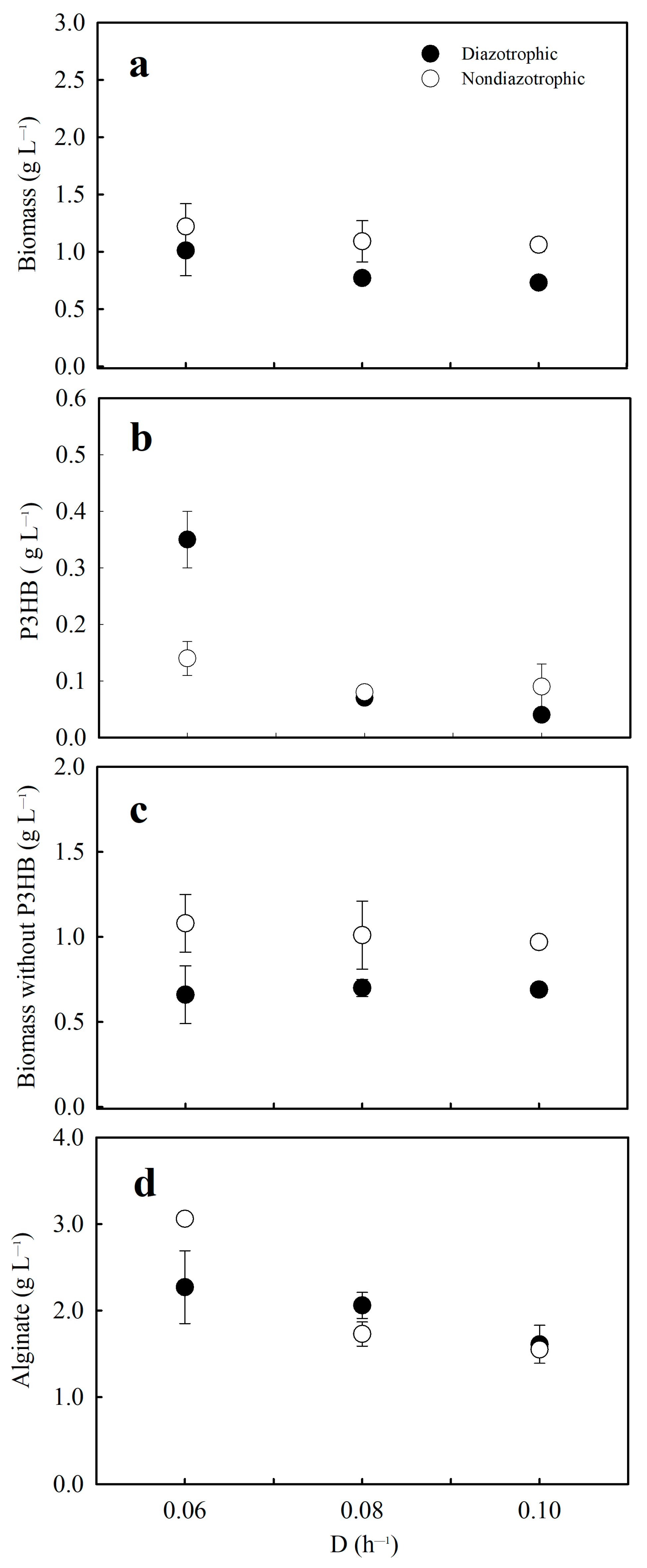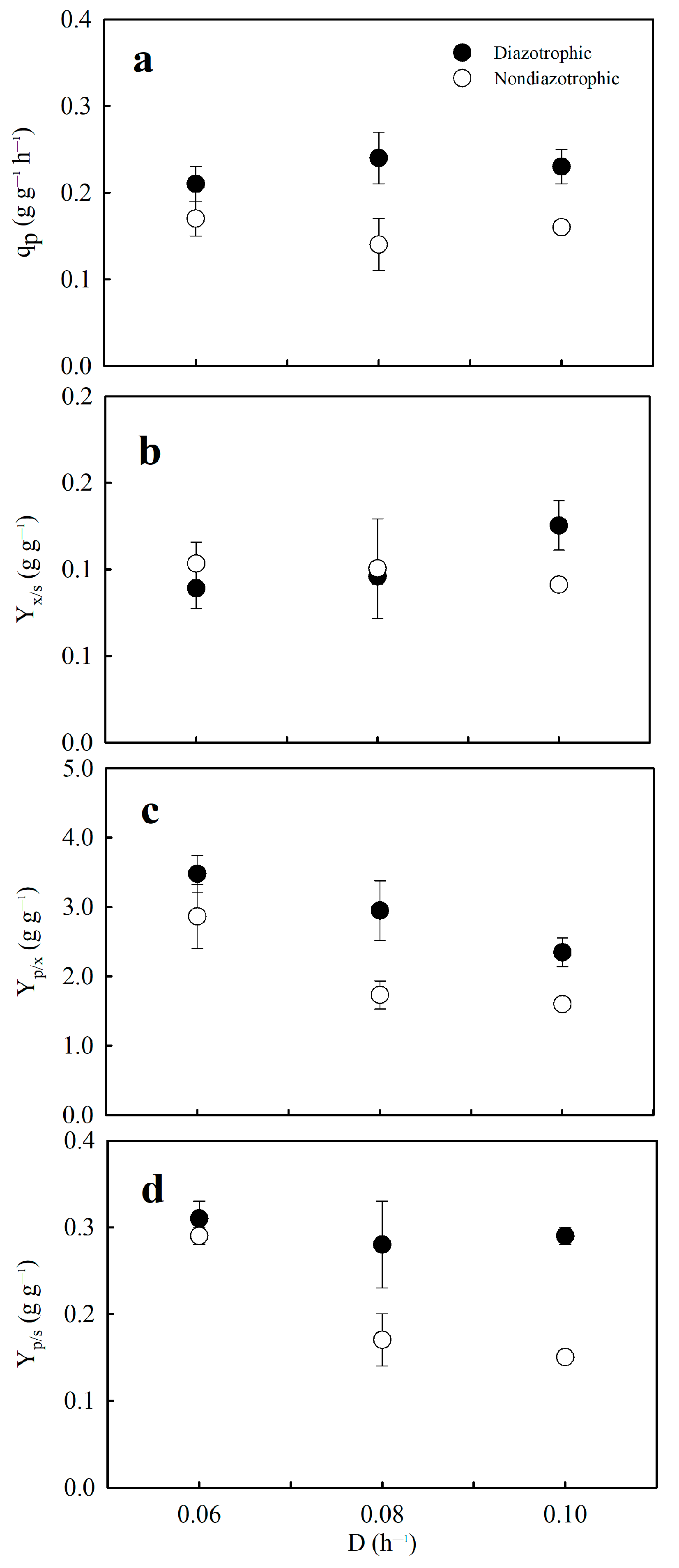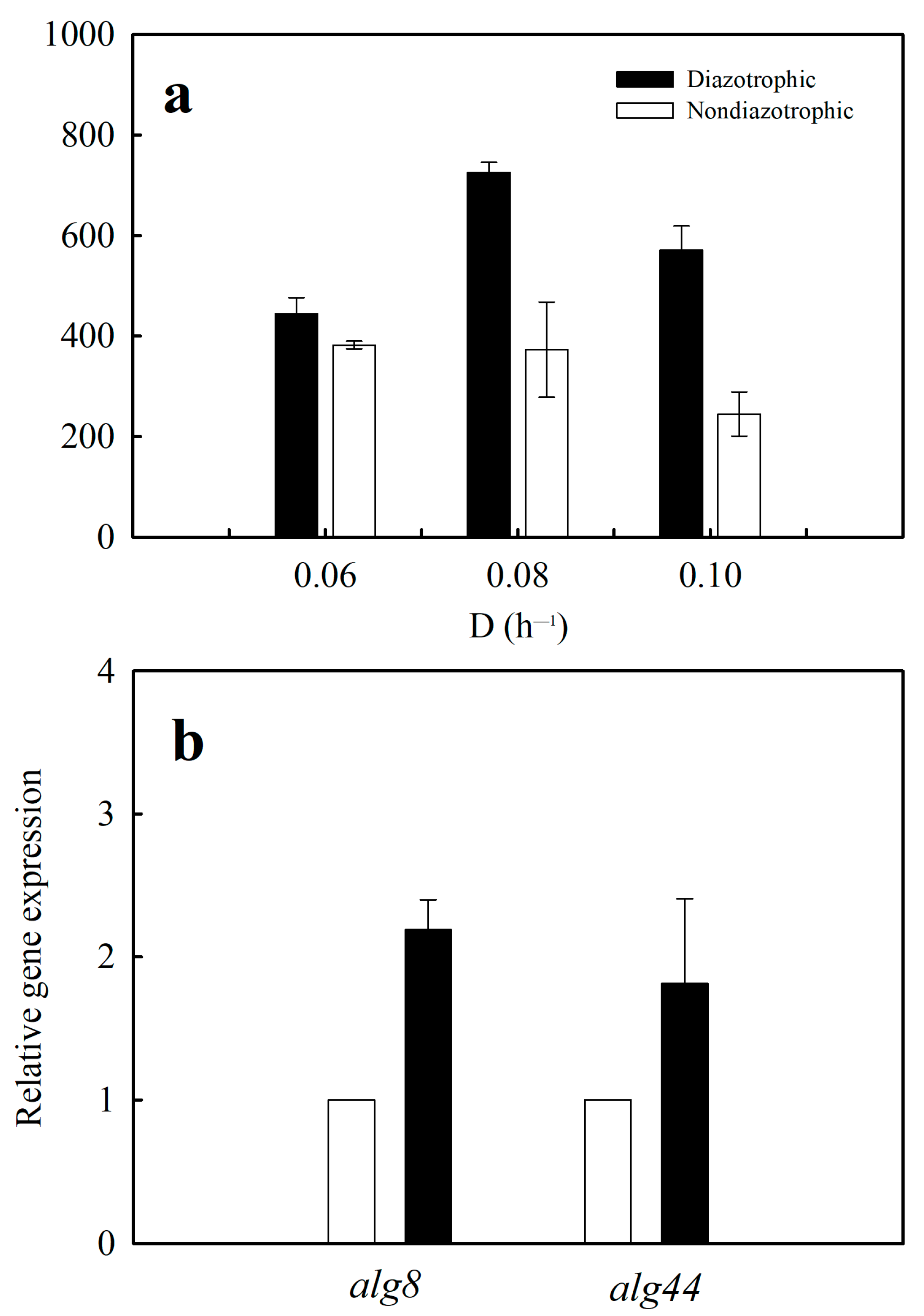Continuous Bioproduction of Alginate Bacterial under Nitrogen Fixation and Nonfixation Conditions
Abstract
1. Introduction
2. Materials and Methods
2.1. Microorganism, Culture Medium, and Inoculum Preparation
2.2. Culture Conditions
2.3. Analytical Methods
2.4. Gene Expression Analysis
2.5. Specific Oxygen Uptake Rate and Respiratory Quotient Determination at the Steady State
2.6. Carbon Balance
2.7. Fermentation Parameters
3. Results and Discussion
3.1. Biomass, P3HB, and Alginate Concentration in the Steady State under Diazotrophic and Nondiazotrophic Conditions
3.2. qO2 and RQ at Different Dilution Rates under Diazotrophic and Nondiazotrophic Conditions
3.3. Alginate-Specific Production Rate and Yields in Continuous Cultures
3.4. Carbon Balance at Different Dilution Rates under Diazotrophic and Nondiazotrophic Conditions
3.5. Alginate Molecular Weight and Gene Expression of alg8 and alg44 in Continuous Cultures
4. Conclusions
Author Contributions
Funding
Institutional Review Board Statement
Informed Consent Statement
Data Availability Statement
Conflicts of Interest
References
- Varaprasad, K.; Karthikeyan, C.; Yallapu, M.M.; Sadiku, R. The significance of biomacromolecule alginate for the 3D printing of hydrogels for biomedical applications. Int. J. Biol. Macromol. 2022, 212, 561–578. [Google Scholar] [CrossRef] [PubMed]
- Galindo, E.; Peña, C.; Núñez, C.; Segura, D.; Espín, G. Molecular and bioengineering strategies to improve alginate and polydydroxyalkanoate production by Azotobacter vinelandii. Microb. Cell. Fact. 2007, 16, 7. [Google Scholar] [CrossRef] [PubMed]
- Ertesvåg, H. Alginate-modifying enzymes: Biological roles and biotechnological uses. Front. Microbiol. 2015, 6, 523. [Google Scholar] [CrossRef] [PubMed]
- Geddie, J.L.; Sutherland, I.W. The effect of acetylation on cation binding by algal and bacterial alginates. Biotechnol. Appl. Biochem. 1994, 20, 117–129. [Google Scholar]
- LeRoux, M.A.; Guilak, F.; Setton, L.A. Compressive and shear properties of alginate gel: Effects of sodium ions and alginate concentration. J. Biomed. Mater. Res. 1999, 47, 46–53. [Google Scholar] [CrossRef]
- Urtuvia, V.; Maturana, N.; Acevedo, F.; Peña, C.; Díaz-Barrera, A. Bacterial alginate production: An overview of its biosynthesis and potential industrial production. World J. Microbiol. Biotechnol. 2017, 33, 198. [Google Scholar] [CrossRef]
- Díaz-Barrera, A.; Soto, E.; Altamirano, C. Alginate production and alg8 gene expression by Azotobacter vinelandii in continuous cultures. J. Ind. Microbiol. Biotechnol. 2012, 39, 613–621. [Google Scholar] [CrossRef]
- Díaz-Barrera, A.; Martínez, F.; Guevara-Pezoa, F.; Acevedo, F. Evaluation of gene expression and alginate production in response to oxygen transfer in continuous culture of Azotobacter vinelandii. PLoS ONE 2014, 9, e105993. [Google Scholar] [CrossRef]
- Oelze, J. Respiratory protection of nitrogenase in Azotobacter species: Is a widely held hypothesis unequivocally supported by experimental evidence? FEMS Microbiol. Rev. 2000, 24, 321–333. [Google Scholar] [CrossRef]
- Inomura, K.; Bragg, J.; Riemann, L.; Follows, M.J. A quantitative model of nitrogen fixation in the presence of ammonium. PLoS ONE 2018, 13, e0208282. [Google Scholar] [CrossRef]
- Sabra, W.; Zeng, A.P.; Lunsdorf, H.; Deckwer, W.D. Effect of oxygen on formation and structure of Azotobacter vinelandii alginate and its role in protecting nitrogenase. Appl. Environ. Microbiol. 2000, 66, 4037–4044. [Google Scholar] [CrossRef] [PubMed]
- Díaz-Barrera, A.; Silva, P.; Berrios, J.; Acevedo, F. Manipulating the molecular weight of alginate produced by Azotobacter vinelandii in continuous cultures. Bioresour. Technol. 2010, 101, 9405–9408. [Google Scholar] [CrossRef] [PubMed]
- Díaz-Barrera, A.; Aguirre, A.; Berrios, J.; Acevedo, F. Continuous cultures for alginate production by Azotobacter vinelandii growing at different oxygen uptake rates. Process Biochem. 2011, 46, 1879–1883. [Google Scholar] [CrossRef]
- Castillo, T.; Galindo, E.; Peña, C. The acetylation degree of alginates in Azotobacter vinelandii ATCC9046 is determined by dissolved oxygen and specific growth rate: Studies in glucose-limited chemostat cultivations. J. Ind. Microbiol. 2013, 40, 715–723. [Google Scholar] [CrossRef]
- Jiménez, L.; Castillo, T.; Flores, C.; Segura, D.; Galindo, E.; Peña, C. Analysis of respiratory activity and carbon usage of a mutant of Azotobacter vinelandii impaired in poly-β-hydroxybutyrate synthesis. J. Ind. Microbiol. Biotechnol. 2016, 43, 1167–1174. [Google Scholar] [CrossRef]
- Ponce, B.; Urtuvia, V.; Maturana, N.; Peña, C.; Díaz-Barrera, A. Increases in alginate production and transcription levels of alginate lyase (alyA1) by control of the oxygen transfer rate in Azotobacter vinelandii cultures under diazotrophic conditions. Electron. J. Biotechnol. 2021, 52, 35–44. [Google Scholar] [CrossRef]
- Díaz-Barrera, A.; Sánchez-Rosales, F.; Padilla-Córdova, C.; Andler, R.; Peña, C. Molecular weight and guluronic/mannuronic ratio of alginate produced by Azotobacter vinelandii at two bioreactor scales under diazotrophic conditions. Bioprocess Biosyst. Eng. 2021, 44, 1275–1287. [Google Scholar] [CrossRef] [PubMed]
- Tec-Campos, D.; Zuñiga, C.; Passi, A.; Del Toro, J.; Tibocha-Bonilla, J.; Zepeda, A.; Betenbaugh, M.; Zengler, K. Modeling of nitrogen fixation and polymer production in the heterotrophic diazotroph Azotobacter vinelandii DJ. Metabolic Chem. Eng. Commun. 2020, 11, e00132. [Google Scholar] [CrossRef]
- Díaz-Barrera, A.; Maturana, N.; Pacheco-Leyva, I.; Martínez, I.; Altamirano, C. Different responses in the expression of alginases, alginate polymerase and acetylation genes during alginate production by Azotobacter vinelandii under oxygen-controlled conditions. J. Ind. Microbiol. Biotechnol. 2017, 44, 1041–1051. [Google Scholar] [CrossRef]
- Miller, G. Use of dinitrosalicylic acid reagent for determination of reducing sugar. Anal. Chem. 1969, 31, 426–428. [Google Scholar] [CrossRef]
- Díaz-Barrera, A.; Urtuvia, V.; Padilla-Córdova, C.; Peña, C. Poly (3-hydroxybutyrate) accumulation by Azotobacter vinelandii under different oxygen transfer strategies. J. Ind. Microbiol. Biotechnol. 2019, 46, 13–19. [Google Scholar] [CrossRef] [PubMed]
- Kaplan, A. The determination of urea, ammonia, and urease. Methods Biochem. Anal. 1969, 17, 311–324. [Google Scholar] [CrossRef] [PubMed]
- Livak, K.J.; Schmittgen, T.D. Analysis of relative gene expression data using real-time quantitative PCR and the 2−ΔΔCT method. Methods 2001, 25, 402–408. [Google Scholar] [CrossRef]
- Schmittgen, T.D.; Livak, K.J. Analyzing real-time PCR data by the comparative CT method. Nat. Protoc. 2008, 3, 1101–1108. [Google Scholar] [CrossRef]
- Díaz-Barrera, A.; Andler, R.; Martínez, I.; Peña, C. Poly-3-hydroxybutyrate production by Azotobacter vinelandii strains in batch cultures at different oxygen transfer rates. J. Chem. Technol. Biotechnol. 2016, 91, 1063–1071. [Google Scholar] [CrossRef]
- Inomura, K.; Bragg, J.; Follows, M.J. A quantitative analysis of the direct and indirect costs of nitrogen fixation: A model based on Azotobacter vinelandii. ISME J. 2017, 11, 166–175. [Google Scholar] [CrossRef]
- Wu, C.; Herold, R.A.; Knoshaug, E.P.; Wang, B.; Xiong, W.; Laurens, L. Fluxomic analysis reveals central carbon metabolism adaptation for diazotroph Azotobacter vinelandii ammonium excretion. Sci. Rep. 2019, 9, 13209. [Google Scholar] [CrossRef]
- Sabra, W.; Zeng, A.P.; Sabry, S.; Omar, S.; Deckwer, W.D. Effect of phosphate and oxygen concentrations on alginate production and stoichiometry of metabolism of Azotobacter vinelandii under microaerobic conditions. Appl. Microbiol. Biotechnol. 1999, 52, 773–780. [Google Scholar] [CrossRef]
- Hoskisson, P.A.; Hobbs, G. Continuous culture-making a comeback? Microbiology 2005, 151, 3153–3159. [Google Scholar] [CrossRef]
- Post, E.; Kleiner, D.; Oelze, J. Whole cell respiration and nitrogenase activities in Azotobacter vinelandii growing in oxygen controlled continuous culture. Arch. Microbiol. 1983, 134, 68–72. [Google Scholar] [CrossRef]
- Alleman, A.B.; Mus, F.; Peters, J.W. Metabolic model of the nitrogen-fixing obligate aerobe Azotobacter vinelandii predicts its adaptation to oxygen concentration and metal availability. Mbio 2021, 12, e02593-21. [Google Scholar] [CrossRef] [PubMed]
- García, A.; Ferrer, P.; Albiol, J.; Castillo, T.; Segura, D.; Peña, C. Metabolic flux analysis and the NAD(P)H/NAD(P)+ ratios in chemostat cultures of Azotobacter vinelandii. Microb. Cell Factories 2018, 17, 10. [Google Scholar] [CrossRef] [PubMed]
- Mazumder, A.; Holdt, S.L.; De Francisci, D.; Alvarado-Morales, M.; Mishra, H.N.; Angelidaki, I. Extraction of alginate from Sargassum muticum: Process optimization and study of its functional activities. J. Appl. Phycol. 2016, 28, 3625–3634. [Google Scholar] [CrossRef]
- Kuhla, J.; Dingler, C.; Oelze, J. Production of extracellular nitrogen-containing components by Azotobacter vinelandii fixing dinitrogen in oxygen-controlled continuous culture. Arch. Microbiol. 1985, 141, 297–302. [Google Scholar] [CrossRef]
- Liparoti, S.; Speranza, V.; Marra, F. Alginate hydrogel: The influence of the hardening on the rheological behaviour. J. Mech. Behav. Biomed. Mater. 2021, 116, 104341. [Google Scholar] [CrossRef]
- Damron, F.H.; Owings, J.P.; Okkotsu, Y.; Varga, J.J.; Schurr, J.R.; Goldberg, J.B.; Schurr, M.J.; Yu, H.D. Analysis of the Pseudomonas aeruginosa regulon controlled by the sensor kinase KinB and sigma factor RpoN. J. Bacteriol. 2012, 194, 1317–1330. [Google Scholar] [CrossRef]
- Flores, C.; Moreno, S.; Espín, G.; Peña, C.; Galindo, E. Expression of alginases and alginate polymerase genes in response to oxygen, and their relationship with the alginate molecular weight in Azotobacter vinelandii. Enzym. Microb. Technol. 2013, 1053, 85–91. [Google Scholar] [CrossRef]




| Gene | Primers | Gene | Primers |
|---|---|---|---|
| alg8-F | 5′-TGTTGAACCAGCTCTGGAAG-3′ | alg8-R | 5′-CCTACCCGCTGATCCTCTAC-3′ |
| alg44-F | 5′-CGACAACTTCACCGAAGGG-3′ | alg44-R | 5′-CGACAACTTCACCGAAGGG-3′ |
| gyrA-F | 5′-ACCTGATCACCGAGGAAGAG-3′ | gyrA-R | 5′-AGGTGCTCGACGTAATCCTC-3′ |
| D (h−1) | Diazotrophy | Nondiazotrophy | ||
|---|---|---|---|---|
| Residual Sucrose (g L−1) | Residual Phosphate (mg L−1) | Residual Sucrose (g L−1) | Residual Phosphate (mg L−1) | |
| 0.06 | 14.2 ± 0.6 | 38.7 ± 11.9 | 8.9 ± 0.2 | 3.4 ± 0.6 |
| 0.08 | 14.2 ± 0.5 | 24.2 ± 0.4 | 8.1 ± 0.5 | 2.7 ± 0.9 |
| 0.10 | 16.1 ± 0.6 | 29.6 ± 5.2 | 9.0 ± 3.1 | 0.7 ± 0.2 |
| Condition | Diazotrophy | Nondiazotrophy | ||||
|---|---|---|---|---|---|---|
| D (h−1) | 0.06 | 0.08 | 0.10 | 0.06 | 0.08 | 0.10 |
| Biomass (%C-mol) | 10.0 ± 1.3 | 10.7 ± 0.5 | 14.0 ± 1.6 | 11.7 ± 1.6 | 11.2 ± 3.2 | 10.1 ± 0.1 |
| Alginate (%C-mol) | 27.5 ± 1.5 | 25.3 ± 4.8 | 26.1 ± 0.7 | 26.8 ± 0.1 | 15.2 ± 2.60 | 13.0 ± 0.2 |
| P3HB (%C-mol) | 6.2 ± 0.1 | 1.2 ± 0.3 | 1.0 ± 0.1 | 1.8 ± 0.3 | 1.0 ± 0.1 | 1.2 ± 0.4 |
| CO2 (%C-mol) | 58.9 ± 3.1 | 56.0 ± 3.9 | 51.5 ± 4.9 | 63.1 ± 7.3 | 57.3 ± 17.2 | 35.7 ± 2.3 |
| C-recovered (%mol) | 103 | 93 | 93 | 103 | 85 | 60 |
Disclaimer/Publisher’s Note: The statements, opinions and data contained in all publications are solely those of the individual author(s) and contributor(s) and not of MDPI and/or the editor(s). MDPI and/or the editor(s) disclaim responsibility for any injury to people or property resulting from any ideas, methods, instructions or products referred to in the content. |
© 2023 by the authors. Licensee MDPI, Basel, Switzerland. This article is an open access article distributed under the terms and conditions of the Creative Commons Attribution (CC BY) license (https://creativecommons.org/licenses/by/4.0/).
Share and Cite
Contreras-Abara, P.; Castillo, T.; Ponce, B.; Urtuvia, V.; Peña, C.; Díaz-Barrera, A. Continuous Bioproduction of Alginate Bacterial under Nitrogen Fixation and Nonfixation Conditions. Fermentation 2023, 9, 426. https://doi.org/10.3390/fermentation9050426
Contreras-Abara P, Castillo T, Ponce B, Urtuvia V, Peña C, Díaz-Barrera A. Continuous Bioproduction of Alginate Bacterial under Nitrogen Fixation and Nonfixation Conditions. Fermentation. 2023; 9(5):426. https://doi.org/10.3390/fermentation9050426
Chicago/Turabian StyleContreras-Abara, Pablo, Tania Castillo, Belén Ponce, Viviana Urtuvia, Carlos Peña, and Alvaro Díaz-Barrera. 2023. "Continuous Bioproduction of Alginate Bacterial under Nitrogen Fixation and Nonfixation Conditions" Fermentation 9, no. 5: 426. https://doi.org/10.3390/fermentation9050426
APA StyleContreras-Abara, P., Castillo, T., Ponce, B., Urtuvia, V., Peña, C., & Díaz-Barrera, A. (2023). Continuous Bioproduction of Alginate Bacterial under Nitrogen Fixation and Nonfixation Conditions. Fermentation, 9(5), 426. https://doi.org/10.3390/fermentation9050426







